The first first part of this article covered: Rods, landing nets, unhooking mats and fish care products. You can find it HERE
In this second part, Ian covers Reels, line, rod rests and alarms, seat and shelters.
The majority of carp angling is undertaken using fixed spool reels. A fixed spool reel is normally controlled by a clutch which may be at the front or at the rear of the reel body. The clutch allows the angler to set the tension at which line can be pulled from the spool with the bale arm engaged. This tension needs to set to prevent breakage of the main line when playing a large fish.
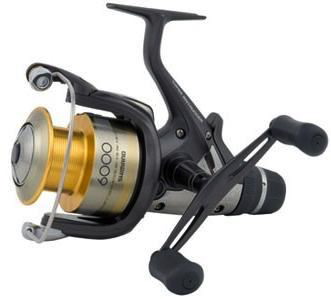 Free-spool reels.
Free-spool reels.
Carp reels fall into two main categories, the first and possibly the most popular is the free-spool reel. Most anglers refer to these as Baitrunners ® (which is a Shimano trade mark) for their easy to use free-spool system. Due to the self-hooking nature of modern carp rigs, when a carp picks up the bait and is hooked they normally spook and swim off at great speed; without a free-spool system, the carp rod and reel would be dragged into the lake. Free-spool reels are available in a whole range of sizes from small reels suitable for Barbel, Tench or Bream fishing with small capacity spools 195M 12lb line through to the biggest which can hold 600m 12lb line.
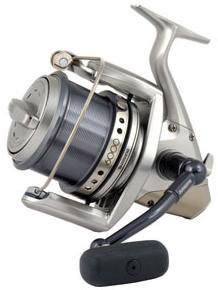 Big pit reels
Big pit reels
Big pit reels are designed to carry large quantities of high diameter line, which is required when tackling large lakes and reservoirs. The extra diameter line (increased breaking strain) would fill a normal spool quickly and therefore creates a lot of line drag when the line leaves the spool during a cast. This drag will greatly reduce your casting range. To ensure you have enough line of the right diameter on the spool for the range you are fishing, a large spooled big pit reel is the answer. These reels have slower gearing and longer reel handles which enable them to have very powerful retrieve capability – which can useful when pulling in a ton of weed or that once in a lifetime huge carp! A front clutch system is the norm on most big pit reels. Some have a standard clutch (which means you have to turn the front drag knob many turns to get the clutch to fully disengage) but others have a quick front clutch which only require a small 90 degree turn to disengage. The front clutch needs to be loosened after you have cast out to achieve the free-spool required when you get a take.
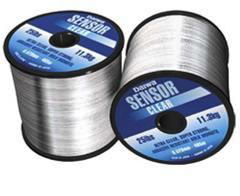 Line
Line
There are two main types of fishing lines available; monofilament and fluorocarbon line. Monofilament line is normally a cheaper line and has a better breaking strain for its given diameter than the same diameter fluorocarbon line. However fluorocarbon line has a couple of advantages over monofilament. Due to the makeup of fluorocarbon, the line has the same light refectory index as water. This means that it is invisible in water once it is laying on the lake bed. It is also a sinking line which means it will sit nicely on the bottom of the lake bed, out of the way of the carp as they swim near your rigs.
Monofilament line has many features and properties which can be useful when fishing. Abrasion resistance, suppleness, knot strength, colour, pre-stretched low-diameter and floating in various breaking strains, the choice is huge. A good value-for-money line is what most people will be looking for. With this in mind I would recommend Daiwa Sensor in either dark or clear, depending upon your preference. It is a line that is supple, knots well and has low diameter with a strong breaking strain. If you are fishing clear lakes with little or no snags, 12lb line which has a diameter of .33mm is ideal. However, if your venue is snaggy or has gravel bars or bed of mussels which can damage your line then 15lb at .37mm or 18lb at .40mm would be more suitable. If you want to spend a little more on your line, Pro Clear by Terry Eustace is a great line that has all the benefits of mono being thin, supple, knots well and best of all sinks like a stone.
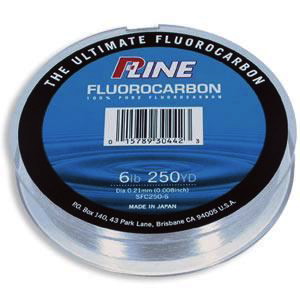 Fluorocarbon line is generally thicker and more wiry. This can make the line more difficult to cast at range. If you are fishing close in or even at mid range you would not notice these problems. A good fluro is P-Line Fluorocarbon, which for a fluro line is remarkably supple and soft. Please note, for fluro you will normally pay double or triple the amount you pay for the same breaking stain monofilament line.
Fluorocarbon line is generally thicker and more wiry. This can make the line more difficult to cast at range. If you are fishing close in or even at mid range you would not notice these problems. A good fluro is P-Line Fluorocarbon, which for a fluro line is remarkably supple and soft. Please note, for fluro you will normally pay double or triple the amount you pay for the same breaking stain monofilament line.
Rod rests and Alarms
To allow the free spool system to work correctly and to keep your nice tackle up off the muddy floor, bank sticks or rod pods are used. Both are effective rod support systems with the rod pods working well on hard ground where putting bank sticks in is difficult. Banksticks are best suited to a more grassy or muddy type bank.
A rod pod normally has four banksticks, one in each corner held vertically in place by interconnecting rods or poles. Due to the large number of joints, rod pods can be difficult to stabilise and in operation be very wobbly.
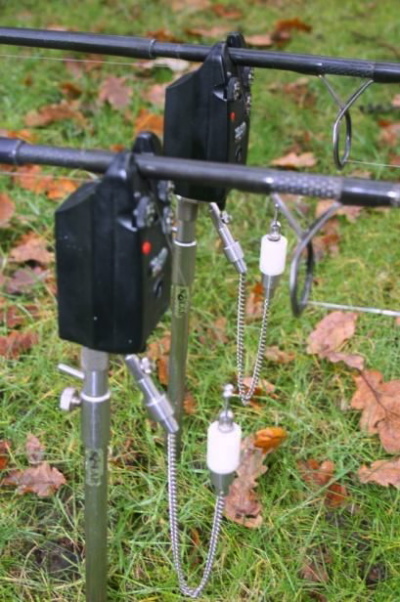 Bank sticks are available in aluminium, steel, stainless steel and carbon fibre. No matter which material you decide upon, they all do the same thing, with a point at one end and a female thread to accept the rod rest or alarm at the other. The rear rod rest should support the rod without damaging the carbon and at the same time grip the rod to help prevent the rod from being dragged into the lake if you have forgotten to turn the free spool on. These have adjustable rubber balls that grip the rod when it is placed upon the rest.
Bank sticks are available in aluminium, steel, stainless steel and carbon fibre. No matter which material you decide upon, they all do the same thing, with a point at one end and a female thread to accept the rod rest or alarm at the other. The rear rod rest should support the rod without damaging the carbon and at the same time grip the rod to help prevent the rod from being dragged into the lake if you have forgotten to turn the free spool on. These have adjustable rubber balls that grip the rod when it is placed upon the rest.
Alarms: With the back of the rod taken care of, we need now to look at the front rod rest which can incorporate an electronic bite detector, more commonly called a bite alarm. Modern alarms work on a simple roller system. When the line is pulled by a carp taking your bait, the roller wheel moves and triggers the alarm to sound with a series of beeps and illuminate a bright LED indicator lamp on the face of the alarm. As with everything in fishing, alarms can be bought with all the features you could want; volume, sensitivity and tone control, from as little as £25.00 each right up to £125.00 each.
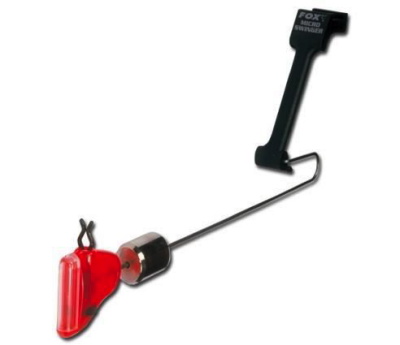 Bobbins: To ensure you keep your line tight over the roller wheel of the alarm, it is normal to use bobbins or swingers. These simply clip to the line just before the alarm and ensure there is sufficient weight of line on the roller so the line does not slip over the roller wheel. It also allows you to see the bite develop as the carp starts its run. Ensure that you get a swinger or bobbins that you can add or remove extra weights to, so you can adjust the tension the bobbin puts on the line for fishing in different situations. Close-in and marginal fishing you can use very light bobbins but the further out you cast the heavier the bobbin you will need.
Bobbins: To ensure you keep your line tight over the roller wheel of the alarm, it is normal to use bobbins or swingers. These simply clip to the line just before the alarm and ensure there is sufficient weight of line on the roller so the line does not slip over the roller wheel. It also allows you to see the bite develop as the carp starts its run. Ensure that you get a swinger or bobbins that you can add or remove extra weights to, so you can adjust the tension the bobbin puts on the line for fishing in different situations. Close-in and marginal fishing you can use very light bobbins but the further out you cast the heavier the bobbin you will need.
Seats and shelters
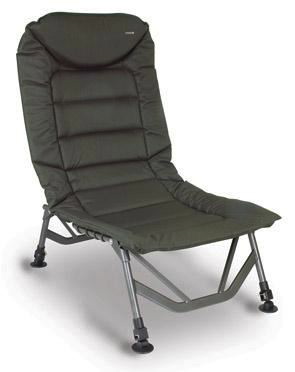 Chairs: To make sure we get the best from our fishing we need to be comfortable so we will need a good chair to sit on. A normal deck chair, although great on a flat patio, is very uncomfortable on the uneven banks of a lake or river so we need to ensure the chair has adjustable feet to level up the chair on the uneven ground.
Chairs: To make sure we get the best from our fishing we need to be comfortable so we will need a good chair to sit on. A normal deck chair, although great on a flat patio, is very uncomfortable on the uneven banks of a lake or river so we need to ensure the chair has adjustable feet to level up the chair on the uneven ground.
There are chairs for every occasion. Small, light, compact chairs for the roving angler who want to be comfortable but at the same time reduce his tackle’s weight, to the fully padded lounging chair, which even offer a reclining back, should you wish to lay back and chill.
Brollies: For many years anglers only had umbrellas to shelter from the weather, these were usually large, heavy, bulky and difficult to get into the ground and despite offering 60” umbrellas, the huge alloy pole in the middle always got in the way. Modern umbrellas are a little better now, with crook for the main pole, to help get it out of the way and side skirts to keep the wind out – but they are still heavy and awkward to set up and use.
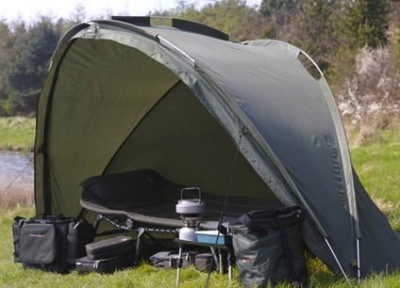 Shelters: Modern shelters are a great leap forward in protection and for the same price as a large umbrella you can get an alloy framed shelter large enough to get two large chairs underneath, plus all of the tackle bags and extras we all take with us. Despite the shelters’ large proportions, once packed down they are often only 1m long and 20cm diameter and weigh a fraction of a traditional brolly. This is a must for every angler who likes to go fishing but can’t stand the British weather.
Shelters: Modern shelters are a great leap forward in protection and for the same price as a large umbrella you can get an alloy framed shelter large enough to get two large chairs underneath, plus all of the tackle bags and extras we all take with us. Despite the shelters’ large proportions, once packed down they are often only 1m long and 20cm diameter and weigh a fraction of a traditional brolly. This is a must for every angler who likes to go fishing but can’t stand the British weather.
Ian Gemson – www.smartcarping.com










